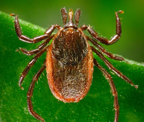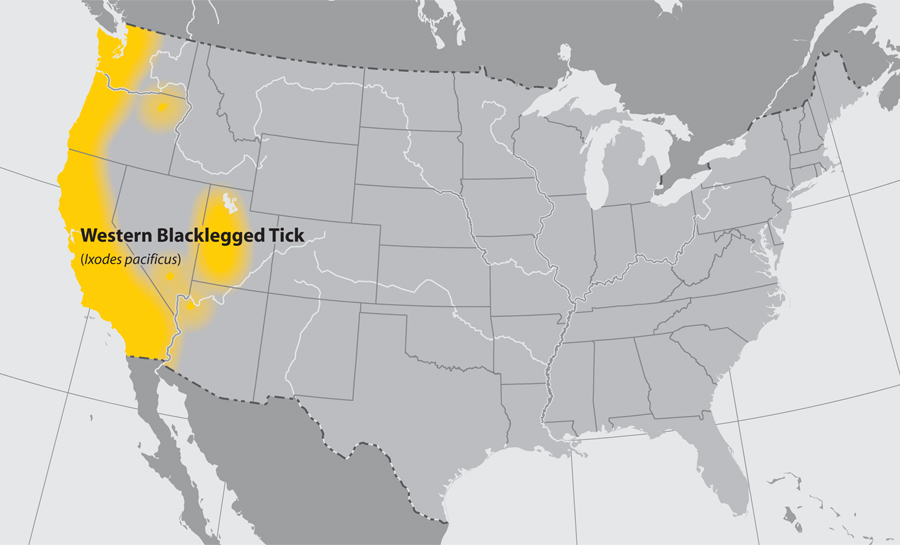Ixodes pacificus: Difference between revisions
Jump to navigation
Jump to search
Gerald Chi- (talk | contribs) mNo edit summary |
No edit summary |
||
| Line 17: | Line 17: | ||
==Overview== | ==Overview== | ||
'''''Ixodes pacificus''''', the '''Western black-legged tick''', is a species of ''[[Ixodes]]'', a [[parasitic]] [[tick]] found on the [[Pacific coast|western coast]] of [[North America]]. It is the principal [[vector (epidemiology)|vector]] of [[Lyme Disease]] in that region.<ref name="pmid11283031">{{cite journal |author=Chang CC, Chomel BB, Kasten RW, Romano V, Tietze N |title=Molecular evidence of Bartonella spp. in questing adult Ixodes pacificus ticks in California |journal=J. Clin. Microbiol. |volume=39 |issue=4 |pages=1221–6 |date=April 2001 |pmid=11283031 |pmc=87914 |doi=10.1128/JCM.39.4.1221-1226.2001 |url=}}</ref><ref name="pmid18787920">{{cite journal |author=Killilea ME, Swei A, Lane RS, Briggs CJ, Ostfeld RS |title=Spatial dynamics of lyme disease: a review |journal=EcoHealth |volume=5 |issue=2 |pages=167–95 |date=June 2008 |pmid=18787920 |doi=10.1007/s10393-008-0171-3 |url=}}</ref> | '''''Ixodes pacificus''''', the '''Western black-legged tick''', is a species of ''[[Ixodes]]'', a [[parasitic]] [[tick]] found on the [[Pacific coast|western coast]] of [[North America]]. It is the principal [[vector (epidemiology)|vector]] of [[Lyme Disease]] in that region.<ref name="pmid11283031">{{cite journal |author=Chang CC, Chomel BB, Kasten RW, Romano V, Tietze N |title=Molecular evidence of Bartonella spp. in questing adult Ixodes pacificus ticks in California |journal=J. Clin. Microbiol. |volume=39 |issue=4 |pages=1221–6 |date=April 2001 |pmid=11283031 |pmc=87914 |doi=10.1128/JCM.39.4.1221-1226.2001 |url=}}</ref><ref name="pmid18787920">{{cite journal |author=Killilea ME, Swei A, Lane RS, Briggs CJ, Ostfeld RS |title=Spatial dynamics of lyme disease: a review |journal=EcoHealth |volume=5 |issue=2 |pages=167–95 |date=June 2008 |pmid=18787920 |doi=10.1007/s10393-008-0171-3 |url=}}</ref> | ||
==Life Cycle== | |||
====General Tick Life Cycle==== | |||
[[Image:Lifecycle.jpg|left|thumb| This image displays an example of the tick lifecycle, based on stages and the months that they are most likely to occur during.]] | |||
*A tick's life cycle is composed of four stages: ''hatching'' (egg), ''nymph'' (six legged), ''nymph'' (eight legged), and an ''adult''. | |||
*Ticks require blood meal to survive through their life cycle. | |||
*Hosts for tick blood meals include mammals, birds, reptiles, and amphibians. Ticks will most likely transfer between different hosts during the different stages of their life cycle. | |||
*Humans are most often targeted during the nymph and adult stages of the life cycle. | |||
*Life cycle is also dependent on seasonal variation. | |||
*Ticks will go from eggs to larva during the summer months, infecting bird or rodent host during the larval stage. | |||
*Larva will infect the host from the summer until the following spring, at which point they will progress into the nymph stage. | |||
*During the nymph stage, a tick will most likely seek a mammal host (including humans). | |||
*A nymph will remain with the selected host until the following fall at which point it will progress into an adult. | |||
*As an adult, a tick will feed on a mammalian host. However unlike previous stages, ticks will prefer larger mammals over rodents. | |||
*The average tick life cycle requires three years for completion. | |||
**Different species will undergo certain variations within their individual life cycles. <ref name="LCT CDC”">Life Cycle of Ticks that Bite Humans (2015). http://www.cdc.gov/ticks/life_cycle_and_hosts.html Accessed on December 30, 2015</ref> | |||
<br> | |||
<br> | |||
<br> | |||
<br> | |||
===Spread of Tick-borne Disease=== | |||
*Ticks require blood meals in order to progress through their life cycles. | |||
*The average tick requires 10 minutes to 2 hours when preparing a blood meal. | |||
*Once feeding, releases anesthetic properties into its host, via its saliva. | |||
*A feeding tube enters the host followed by an adhesive-like substance, attaching the tick to the host during the blood meal. | |||
*A tick will feed for several days, feeding on the host blood and ingesting the host's pathogens. | |||
*Once feeding is completed, the tick will seek a new host and transfer any pathogens during the next feeding process. <ref name="LCT CDC”">Life Cycle of Ticks that Bite Humans (2015). http://www.cdc.gov/ticks/life_cycle_and_hosts.html Accessed on December 30, 2015</ref> | |||
==References== | ==References== | ||
Revision as of 14:43, 16 February 2016
| style="background:#Template:Taxobox colour;"|Ixodes pacificus | ||||||||||||||
|---|---|---|---|---|---|---|---|---|---|---|---|---|---|---|
| style="background:#Template:Taxobox colour;" | Scientific classification | ||||||||||||||
| ||||||||||||||
| Binomial name | ||||||||||||||
| I. pacificus Cooley & Kohls, 1943 | ||||||||||||||
| File:Ixodes pacificus range map.svg |
Editor-In-Chief: C. Michael Gibson, M.S., M.D. [1]
Overview
Ixodes pacificus, the Western black-legged tick, is a species of Ixodes, a parasitic tick found on the western coast of North America. It is the principal vector of Lyme Disease in that region.[1][2]
Life Cycle
General Tick Life Cycle

- A tick's life cycle is composed of four stages: hatching (egg), nymph (six legged), nymph (eight legged), and an adult.
- Ticks require blood meal to survive through their life cycle.
- Hosts for tick blood meals include mammals, birds, reptiles, and amphibians. Ticks will most likely transfer between different hosts during the different stages of their life cycle.
- Humans are most often targeted during the nymph and adult stages of the life cycle.
- Life cycle is also dependent on seasonal variation.
- Ticks will go from eggs to larva during the summer months, infecting bird or rodent host during the larval stage.
- Larva will infect the host from the summer until the following spring, at which point they will progress into the nymph stage.
- During the nymph stage, a tick will most likely seek a mammal host (including humans).
- A nymph will remain with the selected host until the following fall at which point it will progress into an adult.
- As an adult, a tick will feed on a mammalian host. However unlike previous stages, ticks will prefer larger mammals over rodents.
- The average tick life cycle requires three years for completion.
- Different species will undergo certain variations within their individual life cycles. [3]
Spread of Tick-borne Disease
- Ticks require blood meals in order to progress through their life cycles.
- The average tick requires 10 minutes to 2 hours when preparing a blood meal.
- Once feeding, releases anesthetic properties into its host, via its saliva.
- A feeding tube enters the host followed by an adhesive-like substance, attaching the tick to the host during the blood meal.
- A tick will feed for several days, feeding on the host blood and ingesting the host's pathogens.
- Once feeding is completed, the tick will seek a new host and transfer any pathogens during the next feeding process. [3]
References
- ↑ Chang CC, Chomel BB, Kasten RW, Romano V, Tietze N (April 2001). "Molecular evidence of Bartonella spp. in questing adult Ixodes pacificus ticks in California". J. Clin. Microbiol. 39 (4): 1221–6. doi:10.1128/JCM.39.4.1221-1226.2001. PMC 87914. PMID 11283031.
- ↑ Killilea ME, Swei A, Lane RS, Briggs CJ, Ostfeld RS (June 2008). "Spatial dynamics of lyme disease: a review". EcoHealth. 5 (2): 167–95. doi:10.1007/s10393-008-0171-3. PMID 18787920.
- ↑ 3.0 3.1 Life Cycle of Ticks that Bite Humans (2015). http://www.cdc.gov/ticks/life_cycle_and_hosts.html Accessed on December 30, 2015
Gallery
- Common name: western blacklegged tick
- Scientific name: Ixodes pacificus
- Reservoir: birds and small rodents (larvae and nymphs); deer and other mammals (adult ticks)
- Geographic distribution: Pacific coast of the United States
- Disease transmitted: anaplasmosis, Lyme disease
-
Western blacklegged tick (Ixodes pacificus)
Adapted from CDC -
Approximate distribution of the Western Blacklegged tick
Adapted from CDC

